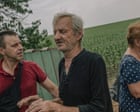
In recent times, the world has witnessed the escalating strains in conflict zones, each conveying profound tales of human resilience and hardship. Among these, Ukraine and Syria stand as potent reminders of the perils that come with prolonged regional disputes, influencing the lives of ordinary citizens.
In Ukraine, the persistent conflict has reached areas that once stood remote from the frontline. The story of Valentyn Velykyi, a 72-year-old pensioner from Maliyivka village, paints a vivid picture of a community caught amidst the tremors of war. Velykyi recalls the ominous signs of war creeping closer, marked by the continuous sounds of explosions and missiles tearing across the sky. His village, positioned between the Dnipropetrovsk and Donetsk provinces, has become increasingly vulnerable as Russian troops expand their presence, pushing further into Ukrainian territories.
The protracted conflict has triggered a significant humanitarian crisis, with many communities, like Maliyivka, now at the forefront. These residents are often left with a challenging choice—stay and risk their lives or abandon their homes in search of safety. As these dynamics unfold, it becomes evident that the progression of war brings not only physical destruction but also profound emotional tolls on those enveloped in its periphery.
Meanwhile, thousands of kilometers away, in the southern parts of Syria, another narrative of conflict turmoil is emerging. The region of Souweida has become the scene of clashes, underlining the enduring communal tensions in the area. Among the affected are the Bedouins, traditionally nomadic groups who have found themselves thrust into the crosshairs of the conflict.
In mid-July, these hostilities have led to dire circumstances for many Bedouin families, who are not just facing the threat of physical violence but also the broader upheavals to their way of life. Alongside the predominant Druze community, these pastoral tribes have experienced harrowing episodes of summary executions and intimidation, forcing many to contemplate fleeing their ancestral lands.
In both Ukraine and Syria, the underlying theme is one of endurance in the face of adversity. While international attention often oscillates based on geopolitical developments, the chronicled stories from these conflict zones serve as a testament to the lived experiences of individuals and communities. With peace prospects fluctuating, the resilience of these populations highlights the importance of diplomatic efforts to forge sustainable resolutions.
Amidst these developments, there is an earnest call from global bodies and local humanitarian organizations for increased efforts to address these crises comprehensively. The urgency is in mitigating the immediate effects of the conflicts and establishing pathways that ensure dignified futures for those whose lives have been upended.
In conclusion, as the situation continues to evolve, fostering a concerted international dialogue remains crucial for alleviating the strains and charting a course towards peace. As these narratives unfold against the broader geopolitical canvas, the focus must remain steadfast on the individuals whose resilience amidst chaos offers hope for a more harmonious tomorrow.
Source: {link}
